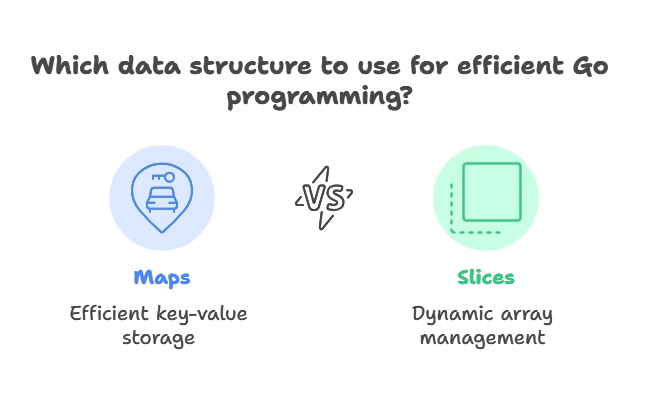Advanced Use of Maps and Slices in Go
Maps and slices are fundamental data structures in Go that offer powerful capabilities for managing collections of data. Understanding their advanced usage can significantly enhance your ability to write efficient and effective Go code.
Understanding Maps
Maps in Go are unordered collections of key-value pairs, where each key must be unique. They are analogous to dictionaries in other programming languages. Let’s delve into some advanced concepts related to maps:
Initialization and Declaration:
// Declaration
var employeeSalary map[string]int
// Initialization
employeeSalary = make(map[string]int)
Explanation: In this code, we declare a map named employeeSalary that maps strings (employee names) to integers (their respective salaries). We then initialize the map using the make() function.
Adding and Updating Elements
employeeSalary["Alice"] = 50000 // Adding a new entry
employeeSalary["Bob"] = 60000 // Adding another entry
employeeSalary["Alice"] = 55000 // Updating an existing entry
Explanation: Here, we add new entries to the employeeSalary map by assigning values to keys. If a key already exists, its corresponding value gets updated.
Deleting Elements:
delete(employeeSalary, "Bob")
Explanation: This line removes the entry for “Bob” from the employeeSalary map.
Iterating Over Maps:
for key, value := range employeeSalary {
fmt.Println("Employee:", key, "Salary:", value)
}
Explanation: The range keyword is used to iterate over all key-value pairs in the employeeSalary map. It returns both the key and the corresponding value in each iteration.
Checking Existence:
salary, exists := employeeSalary["Alice"]
if exists {
fmt.Println("Alice's salary is", salary)
} else {
fmt.Println("Alice's salary not found")
}
Here, we check if the key “Alice” exists in the employeeSalary map. If it does, we print out her salary; otherwise, we indicate that her salary is not found.
Understanding Slices
Slices are dynamic arrays in Go that provide a more flexible way of working with sequences of data compared to fixed-size arrays.
Initialization and Declaration:
var numbers []int
Explanation: This declares a slice named numbers of type int. Unlike arrays, slices don’t require a fixed size at declaration.
Adding Elements to a Slice:
numbers = append(numbers, 1)
numbers = append(numbers, 2, 3, 4)
Explanation: The append() function is used to add elements to a slice dynamically. It takes the slice and the element(s) to be added as arguments.
Slicing Slices:
subset := numbers[1:3]
Explanation: This line creates a new slice named subset that contains elements from index 1 (inclusive) to index 3 (exclusive) of the numbers slice.
Copying Slices:
copyOfNumbers := make([]int, len(numbers))
copy(copyOfNumbers, numbers)
Explanation: The range keyword is used to iterate over all key-value pairs in the employeeSalary map. It returns both the key and the corresponding value in each iteration.
Resizing Slices:
numbers = append(numbers, 5)
Explanation: Here, we create a new slice named copyOfNumbers with the same length as numbers and then copy the elements of numbers into it.

In conclusion, understanding the advanced usage of maps and slices in Go is crucial for writing efficient and elegant code. With the concepts covered in this chapter, you now have a solid foundation to leverage the full potential of maps and slices in your Go programs. Practice these concepts, experiment with different scenarios, and continue to explore the rich features of the Go language to become a proficient Go developer. Happy coding !❤️
